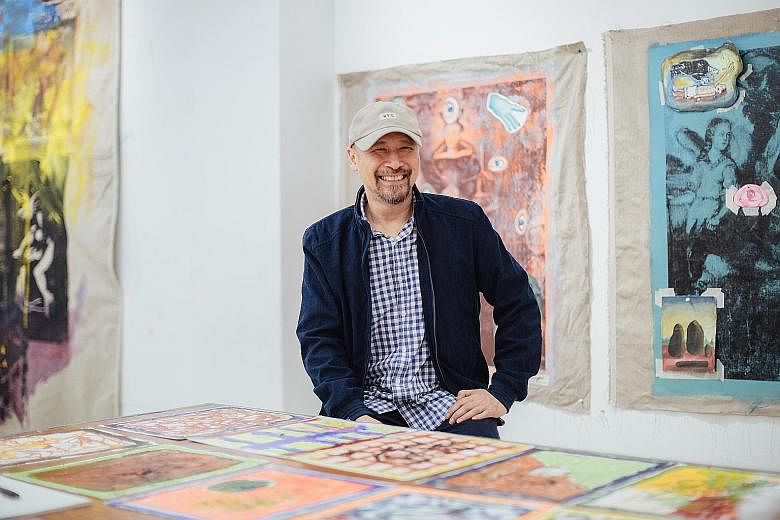"Nutty humour on the dark side with spicy evil notes and aromas of moldy dungeon evoking musty playboy mansions for geriatrics."
This is how Filipino artist Manuel Ocampo, with characteristic irreverence, describes his solo show in Singapore in a nutshell.
The candid 54-year-old, who gained critical acclaim in the 1990s for his paintings which incorporated religious and cultural iconography, began a residency at the STPI - Creative Workshop & Gallery in Robertson Quay last year. His works on the walls of the gallery are the upshot of this and feature a range of techniques such as lithography, screenprint, collagraphy, and etching.
Titled Ideological Mash-Up/ Remix, the exhibition, which runs till June 22, also features recurring motifs such as eyes, buzzards and religious iconography. Ocampo, who was raised Catholic, is now agnostic and "culturally Catholic".
The artist says in an e-mail interview that the "mash-up" of images in the show is "reflective of our culture in general".
Lifting a remark from American artist Sterling Ruby, the self-regarded cultural scavenger suggests that ours is a world in which "there is just too much information for anything to be coherent or whole".
The Singapore show features two 10m-long canvases on opposite walls titled If All You Are Is A Nail Then Everything Looks Like A Hammer. They include a motley cast of figures ranging from images of Nazi officers to people from American ethnic groups.
-
VIEW IT/ MANUEL OCAMPO: IDEOLOGICAL MASH-UP/REMIX
-
WHERE: STPI - Creative Workshop & Gallery, 41 Robertson Quay
WHEN: Till June 22; 10am to 7pm (weekdays) and 9am to 6pm (Saturdays)
ADMISSION: Free
INFO: www.stpi.com.sg/exhibitions/manuel-ocampo-ideological-mash-up-remix/
Asked about the ideologies explored in the show, the artist is evasive. "I just go for the look. I try not to critique or maybe I do unconsciously, but this is not my aim," says Ocampo, whose paintings were in 1992 removed from the Documenta art show in Germany because some of them incorporated the Nazi swastika symbol.
Some of his exhibits at STPI seem to poke fun at the figure of the gallery visitor who wants to know what the artworks mean.
One work made from Chinese ink on handmade paper features question marks and a seemingly uprooted sign that would have otherwise pointed to "Heterotopia". Another artwork, titled Diversity, Inclusivity, Equity, contains a cutout with the words "Ha ha what does this represent?"
It "pains" him to explain his work, Ocampo says.
"I don't know why I chose certain elements from other elements. Once you start to give a reason as to why you're doing something, it's already a lie."
The artist, who is based in Manila but has also lived in the United States, has several works in the collections of international museums such as the Museum of Contemporary Art in Los Angeles and Fukuoka Asian Art Museum in Japan.
Collaborating with STPI gave him the chance to experiment with processes such as paper pulp painting, paper making, paper relief and aquatint. The paper used for Sign Points Heterotopia, for example, was made from linen pulp. The wet material had the look and texture of a drenched towel, and, when he drew on it, the ink spread "uncontrollably", much to his delight.
He adds: "This process brings to mind a lot of childhood memories playing with wet toilet paper and soaked in ink and throwing it onto the walls of my school."
The artist, inspired by the sight of his messy computer desktop, has collages in some of the works.
He chose images "indicative of our current obsession with the grotesque and cringeworthy" - citing as examples the He-Man and the Masters of the Universe memes, oiled up female body-builders, religious iconography, SpongeBob Squarepants "cartoon porn", rotten teeth, Billy Ray Cyrus, and Make America Great Again hats.
Some works, painted on the walls in Deep Faith - the name of a kind of purplish paint - were inspired by Singapore and range from an artistic reproduction of the Danger: Keep Out sign to a chart of "abstract art" that maps the names of local foods.
With age comes a certain sense of freedom, he says.
"Your duty is to your creation and you tend not to care what people think anymore. When you paint a certain colour, you don't struggle anymore to think of 'what it means', but you just do it because you felt like it," says Ocampo, who plans to move to Bataan, a province a more than two-hour's drive from the capital.
He plans to explore photography and move from figurative painting to more abstract works "so I don't have to explain what they mean".
One thing that worries him about the art world today, he adds, is that "everyone is or can be an artist - and that being an artist today is seen as a career move".
"When I was starting out and you tell people you are an artist, people think you are a misfit, you are a drug addict, or something short of being a madman on the way to the loony bin... Now artists wear expensive clothes, hang out with the elites, spout out critical theoretical tracts out of memory, jet-set to the Carribbean and basically have a rock-and-roll lifestyle.
"Young artists today are being used by the market, because today, especially in the Philippines, young artists will just copy a work because it was successful in the auction house. Their work becomes formulaic, predictable and the art scene becomes stagnant as everyone wants a piece of the auction house pie. Gone are the days when your studio sofa is your best friend."



